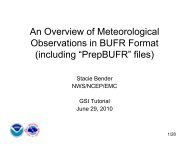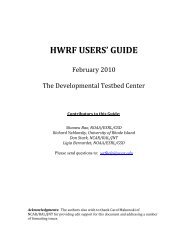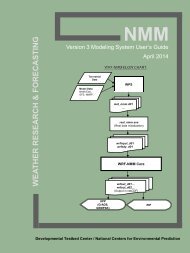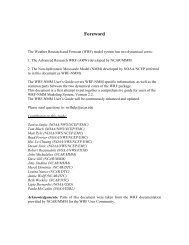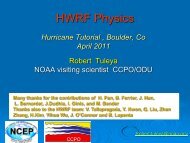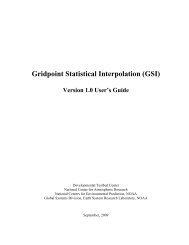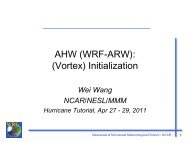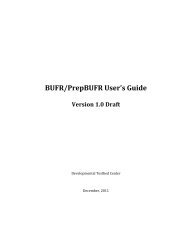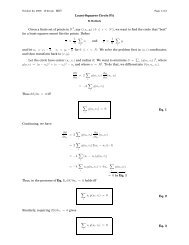WRF - Developmental Testbed Center
WRF - Developmental Testbed Center
WRF - Developmental Testbed Center
- No tags were found...
Create successful ePaper yourself
Turn your PDF publications into a flip-book with our unique Google optimized e-Paper software.
Program geogridThe purpose of geogrid is to define the simulation domains, and interpolate variousterrestrial data sets to the model grids. The simulation domains are defined usinginformation specified by the user in the “geogrid” namelist record of the WPS namelistfile, namelist.wps. In addition to computing the latitude, longitude, and map scale factorsat every grid point, geogrid will interpolate soil categories, land use category, terrainheight, annual mean deep soil temperature, monthly vegetation fraction, monthly albedo,maximum snow albedo, and slope category to the model grids by default. Global data setsfor each of these fields are provided through the <strong>WRF</strong> download page, and, because thesedata are time-invariant, they only need to be downloaded once. Several of the data setsare available in only one resolution, but others are made available in resolutions of 30",2', 5', and 10'; here, " denotes arc seconds and ' denotes arc minutes. The user need notdownload all available resolutions for a data set, although the interpolated fields willgenerally be more representative if a resolution of data near to that of the simulationdomain is used. However, users who expect to work with domains having grid spacingsthat cover a large range may wish to eventually download all available resolutions of thestatic terrestrial data.Besides interpolating the default terrestrial fields, the geogrid program is general enoughto be able to interpolate most continuous and categorical fields to the simulation domains.New or additional data sets may be interpolated to the simulation domain through the useof the table file, GEOGRID.TBL. The GEOGRID.TBL file defines each of the fields thatwill be produced by geogrid; it describes the interpolation methods to be used for a field,as well as the location on the file system where the data set for that field is located.Output from geogrid is written in the <strong>WRF</strong> I/O API format, and thus, by selecting theNetCDF I/O format, geogrid can be made to write its output in NetCDF for easyvisualization using external software packages, including ncview, NCL, and the newrelease of RIP4.Program ungribThe ungrib program reads GRIB files, "degribs" the data, and writes the data in a simpleformat, called the intermediate format (see the section on writing data to the intermediateformat for details of the format). The GRIB files contain time-varying meteorologicalfields and are typically from another regional or global model, such as NCEP's NAM orGFS models. The ungrib program can read GRIB Edition 1 and, if compiled with a"GRIB2" option, GRIB Edition 2 files.GRIB files typically contain more fields than are needed to initialize <strong>WRF</strong>. Both versionsof the GRIB format use various codes to identify the variables and levels in the GRIBfile. Ungrib uses tables of these codes – called Vtables, for "variable tables" – to definewhich fields to extract from the GRIB file and write to the intermediate format. Detailsabout the codes can be found in the WMO GRIB documentation and in documentation<strong>WRF</strong>-NMM V3: User’s Guide 3-3



